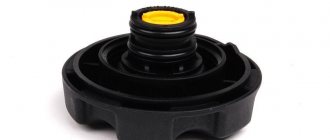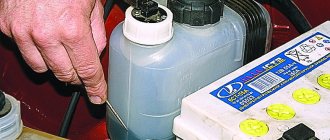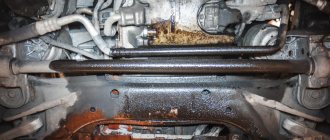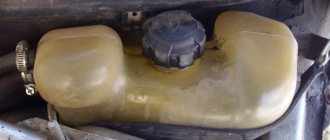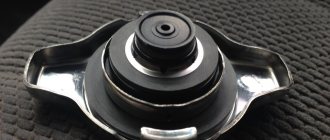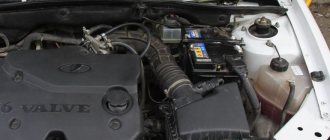The attention of drivers who are accustomed to servicing their car themselves is usually focused on the engine and chassis. Of course, these components are considered basic in the operation of the entire car. However, equal attention must be paid even to such seemingly insignificant details as the cap on the expansion tank. What role does this element play in the cooling system? Most drivers don’t even realize that the quality of engine cooling depends entirely on this cover!
What is the main role of the tank cap?
As is known, a running engine creates a pressure in the cooling system that differs from normal atmospheric pressure. This occurs due to the fact that the coolant heats up along with the engine, as a result of which it expands and increases in volume. As a result, the pressure inside the engine cooling system (ECS) increases, but it is not in contact with the external environment, and there is nowhere for it to relieve excess pressure.
Developers of modern cars do not fight the increased pressure in the ODS “radically” - they do not try to completely get rid of it. It is adjusted using the tank cap. Increased pressure in the SOD is used to shift the coolant boiling point. After all, it’s no secret that at normal atmospheric pressure for water it occurs at a temperature of 100 °C, for antifreeze – 105–110 °C, and for antifreeze – 120 °C. The operating temperature of modern car engines is very close to these critical values.
So, for example, for carburetor VAZs it should be in the range of 90–95 °C, and for injection ones – 97–105 °C.
However, under certain engine operating conditions, a short-term increase in its temperature occurs to higher values, which, however, does not lead to failure of a serviceable engine, but causes the same heating of the coolant. For example, on injection VAZ 2109 the liquid at such moments can be 120–125 °C. Obviously, even antifreeze cannot withstand such heat. At the same time, an increase in the pressure of any liquid leads to an increase in its boiling point.
Injection VAZ 2109
Engineers designing engines have long found out that to prevent the coolant from boiling even during short-term critical heating of the engine, it is enough to maintain the pressure in the coolant at the level of 1.1–1.5 kgf/cm 2 (1.1–1.5 bar). A higher temperature is not needed, because the engine is not designed for it, and it will lead to its failure. And it makes no sense to allow a greater spontaneous increase in pressure, which can nevertheless occur, because it will complicate the process of manufacturing and servicing the motor, as well as increase its cost, since it will require a more durable and sealed SOD (more durable pipes and expansion tank, strong clamps).
Therefore, the tank lid must be sealed, but only up to the required pressure limits indicated above, after reaching which it maintains them, connecting the system with the external environment as necessary to release the air compressed inside the expansion tank.
The design and principle of operation of the expansion tank cap
In order for the necessary pressure to be created in the SOD when the engine is running, the lid device ensures a tight, hermetically sealed closure of the tank. A safety valve is provided to relieve excess pressure. It operates (opens) only when the pressure inside the SOD becomes 1.1–1.5 kgf/cm2 (depending on the design of the lid and its manufacturer).
While it is lower, the valve is closed, and immediately after releasing the excess pressure to a value that is less than that indicated above - partial release of the air compressed in the tank - it closes. There is one more valve in the lid - the inlet valve, it is also called a vacuum valve. Its purpose is exactly the opposite of protective. The inlet valve serves to intake (suction) air into the SOD. The fact is that after stopping the engine, as you know, it begins to cool down. The coolant temperature also drops.
Inlet valve cover
At the same time, it decreases in volume, which is accompanied by a decrease in pressure inside the SOD. The coolant that enters the tank, upon its own heating, begins to flow back into the system, freeing up space for the air remaining in the expansion tank and ceasing to put pressure on it. Then there comes a moment when the pressure in the SOD is compared with the external atmospheric pressure. If at the same time the temperature of the coolant turns out to be higher than in the external environment, then it, continuing to cool, will further decrease in volume.
This will lead to the pressure in the SOD becoming lower than atmospheric, that is, to a vacuum effect. The outside air will put pressure on the elements of the system and will tend to occupy its internal volume. If there is a “weak” place in any part of the SOD, where the tightness is broken when it cools and pressure exerted from outside, then air will enter the system and a so-called air lock may form in it. When the engine is started again, it can, of course, be pushed out by coolant into the expansion tank.
Auto coolant
But if this does not happen, the air lock will disrupt the circulation of fluid in the SOD, prevent the engine from cooling, and may even cause it to fail. Typically, air enters the system due to suction between the pipes and fittings on which they are mounted. To prevent this from happening, the pressure in the SOD is equalized with the external atmospheric inlet valve. It is triggered when there is a vacuum in the system of 0.03–0.1 kgf/cm 2 and admits air into the expansion tank, which actually replaces the coolant pushed out through the safety valve when heated. The internal pressure in the SOD is equalized with the external one.
Location of expansion tank
A plastic reservoir for excess coolant is installed by the manufacturer in different places depending on the model of the “tenth” family:
- in cars of the VAZ 2110-12 series, the reservoir is located on the left side (in the direction of travel) between the pillar glass and the wall of the interior partition;
The expansion tank on VAZ 2110-12 models is installed in a narrow niche on the driver’s side
In cars of the 2114-2115 series, the tank is located in front of the pillar
The expansion tank is attached to the body elements with a clamp in the form of a flat rubber belt with a metal hook that hooks onto a protrusion on the side member. There are 3 hoses connected to the tank:
- A large diameter pipe leading from the thermostat is connected to the bottom.
- The upper tube of small diameter goes through the partition to the radiator of the cabin heater.
- The middle small tube connects the tank to the upper fitting of the main cooling radiator.
The reservoir compensates for the expansion of coolant and steam from three elements of the system - the cabin heater, the radiator and the main line near the thermostat
On some modifications there is a reservoir with two fittings and connecting pipes - the large one comes from the thermostat, and the small one from the main radiator; there is no connection to the stove.
Each hose performs a separate function. The thick pipe serves to expand the coolant and fill the system while pouring antifreeze through the neck of the tank. Two thin tubes are designed to drain the steam-water mixture from the stove and the main radiator into the tank when heated to the maximum permissible antifreeze temperature of 95 ° C.
Signs and possible consequences of a part malfunction
Most often, the consequence of a malfunction of the cap is boiling of the coolant, sometimes accompanied by the ejection of the coolant from the expansion tank - a common occurrence for VAZ cars. If this happens at engine operating temperatures, then most likely the plug does not hold the required pressure.
Car coolant boiling
Another reason for the same phenomenon is that due to a malfunction of the vacuum valve, air entered the ODS and formed a plug, which disrupts normal circulation, and therefore the cooling of the coolant. In winter, due to an air lock, the stove may not work well. Unpleasant consequences: loss of coolant, which has to be topped up regularly. This happens when, due to increased pressure in the SOD, liquid is “expelled” through the joints between the fittings and pipes put on them, through clamps.
- rupture of low-quality pipes or those that have not been changed for a long time (a picture familiar not only to VAZ owners);
- the appearance of a leak in the main or heating radiator;
- tears the thermostat housing (for Nexia it’s a common thing - into 2 parts);
- burst expansion tank.
A leak appears in the main radiator
All these signs and consequences of a malfunctioning lid are the result of increased pressure in the SOD. The latter is not uncommon for VAZ 2108, 2109 and especially 2110 cars with new-style tanks. Of course, it is obvious that the plastic of these expansion tanks leaves much to be desired, but, nevertheless, this is also due to a malfunction of the plug. So the lid, by regulating the pressure in the SOD, also protects its elements from mechanical damage.
Classic lid upgrade method
Upgrading the cover in this embodiment involves removing and disassembling the component. We take out the rubber seal and the internal assembly (a pair of springs with a valve). We use a screwdriver.
Refinement involves trimming two springs. The first of them must be shortened by one turn, and the second by as many as two. We assemble according to a well-known algorithm. After this, we check the functionality of the upgraded node. The valve outlet element will now begin to open when the pressure reaches 1 bar. Previously, this figure was 1.7 bar.
Upon successful completion, the lid can be easily blown through the mouth. This check ensures there is free passage of air in both directions. If the indicated effect is observed, then we can state that the modification is correct. Now the risk of airing the circuit has been reduced many times over.
How to check the cover and identify problems?
Before checking the expansion tank cap, it must first be inspected to make sure that it is intact and has no mechanical damage in the form of scratches, cracks and severe wear, and is also free of rust, dirt, scale and other defects. Then you should check the functionality of its valves. Several simple diagnostic methods that allow you to only approximately determine their serviceability are given below.
For safety valve. With the engine running and warm, loosen the cap. There should be a hissing sound of compressed air coming out of the tank. This means the valve holds pressure. But not every professional can determine which one exactly.
Unscrewing the tank cap
- If the SOD pipes look deformed (compressed, flat) before starting the engine for the first time in the morning, the valve is definitely faulty.
- Unscrew and remove the cover. Then we strongly squeeze one of the SOD pipes and, holding it like that, install and screw the plug back. Let go of the pipe. If it begins to take its original shape, the valve is most likely working.
A more reliable way to check the operation of the valves is to use a pump with a pressure gauge. You will also need any empty expansion tank. We connect to one of its fittings, and then fix with a clamp the pump hose, from which the tip for the nipple was previously removed. We plug the remaining outputs from the tank with some kind of plugs. Then close the tank with the lid being tested.
Pump with pressure gauge
You can also check it on the tank installed on your car without draining the coolant. To do this, for example, on a VAZ 2109, we disconnect from the expansion tank the pipe that comes from above and removes steam from the SOD. We install a pump hose instead. In order to plug it, we insert something of a round cross-section and suitable diameter, for example, a drill, into the disconnected pipe. Then we put a clamp on this hose and tighten it.
We turn on the pump and, watching the needle on its pressure gauge, record the moment a click appears, followed by a hissing sound coming out of the tank through the air plug. If this happened at around 1.1–1.5 kgf/cm2, and further pumping only leads to increased hissing, but the pressure does not increase, it means that the vacuum valve is not leaking, and the safety valve is working as expected.
Validity check
Since such procedures must be regular, it is better to bother once and build yourself a testing apparatus. For it, the simplest pump with a pressure gauge and an expansion tank are combined into a single whole (you can spend money once so as not to reinvent the wheel from scrap materials). It is necessary to check both valves - both exhaust and intake. For the first, with the lid screwed on, air is pumped into the tank until a characteristic hissing sound appears.
If it was heard at a pressure of no higher than 1.2 atmospheres, the valve is already half alive. To make sure of its second half, wait until the end of the hissing and measure the remaining pressure. Should keep 0.8. At the first pressure above the specified value, the spring is gradually trimmed - and each time checked. When bleeding less than 0.8, the spring is stretched or washers are slipped under it.
Refinement of a new part - what to do if it does not function?
When it turns out that the lid stubbornly refuses to relieve excess pressure and/or is not able to restore air losses in the SOD, it can be modified. For some reason, the most complaints come from owners of VAZ, model 2109, including those who buy new plugs. It is clear that the reason for the incorrect operation of the cover valves lies in the too much rigidity of their springs.
To modify the cover, for example, for a VAZ 2109, it must first be disassembled. This must be done carefully, using pliers and a thin flat-blade screwdriver. We must try to remember where everything stood so that the springs do not fly away to God knows where. After the lid for the VAZ 2109 tank has been disassembled, it’s time for the wire cutters. They need to shorten the springs: the large one, for the safety valve, usually by 1 turn, and the small one by 2.
Verification Instructions
Trying to create pressure with your mouth in order to check the functionality of a potentially failed valve cover from the expansion tank is usually in vain. It is better to abandon such an idea. Otherwise, there is a risk of drinking antifreeze. And if he is also hot, then a visit to the hospital cannot be avoided.
The easiest way to check it is at a car service center. There are special pumps to create pressure. They pump the required number of atmospheres, which makes it clear whether the valve operates or not.
But many are interested in self-checking. It is also possible.
Here you need to act according to a certain algorithm.
- First, turn off the engine, let it cool for a while, then carefully unscrew the cap from the tank. Examine its condition visually. Any breaks in the seal, chips or cracks indicate the need for replacement;
- In the absence of mechanical damage, there is still no guarantee that the element is in working order. Screw the plug into place, turn on the engine at idle speed;
- Wait until the engine temperature reaches operating parameters;
- Listen carefully, standing near the tank, to see if there is any hissing in the area of the lid. The sound is reminiscent of opening a can of soda;
- If there is a hissing sound, this directly indicates that the valve is holding excess pressure inside and not releasing it;
- If there is no hissing, check the operation for pressure build-up. To do this, feel the pipes that are accessible without difficult dismantling;
- If they are pressed in and compressed from the inside, then the discharge valve does not work.
A fairly simple but effective way to check yourself. Its advantage is that this method is suitable for any car with a liquid engine cooling system.
There are alternative diagnostic options, but they cannot always be carried out due to the design features of the motor. If you can reach up and reach one of the thick hoses coming from the coolant reservoir. It is compressed, and before that the plug is unscrewed. Squeeze the hose, tighten the plug, and then release the tube. If it returns to its original shape, the valve performs its functions.
Despite such a modest size and external inconspicuousness, such an element of the cooling system has a huge impact on the performance of the entire engine. Therefore, you should definitely remember the reasons, signs and methods for diagnosing the condition of the valve plug on the expansion tank.
Consequences of a broken tank cap
Many drivers very rarely pay attention to the tank cap, and are not even aware of the important role it plays in the entire cooling system. Many people do not open this lid for years, and it begins to sour. The valves stop working correctly, and at one point, due to a lack of tightness in the cooling system, air pockets form. The car begins to boil and the interior heater stops working. An overheated engine fails and can be quite expensive to repair. It also happens that the exhaust valve jams, and then excess pressure forms in the cooling system, which can rupture the pipes, cooling radiator, heater radiator, or make its way into the engine crankcase through the cylinder head gasket. And this is not counting the smaller engine parts, such as the pump, thermostat. Eliminating the consequences is very expensive. All these malfunctions occurred simply due to the breakdown of such a seemingly insignificant part as the expansion tank cap.
How to check the cover valves
Care will help you avoid such breakdowns. It is necessary to carry out a visual inspection of the engine and all vehicle fluids at least a couple of times a month. Much, of course, cannot be seen with the untrained eye, but if there are any suspicions about the operation of the engine and cooling system, you should immediately contact a specialist. And the cover itself, to ensure that the valves are working properly, can be checked quite simply. Firstly, it should not be dirty, oxidized or with traces of corrosion. Secondly, the inner surface of the lid must always be clean, the valves must be pressed smoothly when pressed with a finger. If you hold the cap to your ear and press the release valve, a faint sound should be heard, like a whistle, and when you remove your finger from the valve, the sound should be hissing, as if air is being drawn in. You can use a pump with a pressure gauge to check the cover. Having removed the thinnest, upper pipe from the tank, you need to attach a pump to the tank and start supplying air. The exhaust valve should be triggered by a pressure of no more than 1.5 kilograms per square centimeter, or in other words 1.5 atmospheres. If the valve does not operate, the cap must be replaced. Through such simple manipulations, you can determine the serviceability of the expansion tank cap and eliminate the malfunction in time, which will protect the car engine from serious damage.
Refinement of the cover
Some people modify the covers by trimming the valve springs by a few turns. I don't recommend doing this. This is not such an expensive part that you would bother with it so much.
If the lid does not work, you can always return it to the store and try another one. Some people spend quite a long time searching for a lid until they find the right one. This is due to the fact that (in most cases) there are many fakes, as well as for other reasons, for example, the buyer does not read the response temperature of the valve on the lid, fills in cheap antifreeze or water, which has a detrimental effect on the cooling system.
If the expansion tank cap breaks on the road
It also happens that the cover breaks during a long trip, when the owner is not able to contact a car repair shop. In this case, one simple method will help. The tank cap is disassembled and the valve spring is removed, which will avoid creating high pressure in the system. This will allow you to continue moving about 20-30 kilometers. By stopping after every 20-30 kilometers and letting the fluid cool a little, you can drive to the nearest car service center, where specialists will completely eliminate the problem.
Is it possible to ride with the reservoir cap slightly open? Watch the video:
And finally, some good advice. Be attentive to your iron horse, and it will not let you down at the most unexpected moment.

